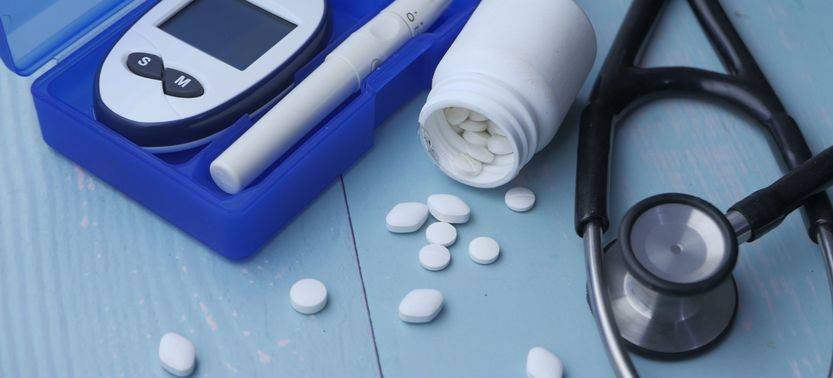6 Fast Facts About Type 2 Diabetes
If you haven’t been diagnosed with type 2 diabetes, chances are you probably know someone who has. That’s because older adults are at increased risk of diseases that impact their ability to regulate their blood sugar as they age. For some, it’s a matter of genetics. For others, it’s triggered by lifestyle and diet choices. But those who are diagnosed with type 2 diabetes, also known as adult-onset diabetes, can continue to live active, healthy lives if they make the right changes.

If you haven’t been diagnosed with type 2 diabetes, chances are you probably know someone who has. That’s because older adults are at increased risk of diseases that impact their ability to regulate their blood sugar as they age. For some, it’s a matter of genetics. For others, it’s triggered by lifestyle and diet choices. But those who are diagnosed with type 2 diabetes, also known as adult-onset diabetes, can continue to live active, healthy lives if they make the right changes. Here’s what you need to know about type 2 diabetes:
1. Type 2 Diabetes Is Common in Older Adults
According to the CDC, more than 34 million Americans (about one in 10) have diabetes, and approximately 90%-95% of them have type 2 diabetes. Overall, as many as 25% of adults older than 65 have type 2 diabetes, while half of people over 65 have prediabetes. Why is this so prevalent? Our bodies have more trouble regulating insulin levels as we age, and pancreatic function can become impaired. This results in an inability of the body to create proper levels of insulin to regulate glucose levels.
Here’s the definition of type 2 diabetes from the Mayo Clinic:
Type 2 diabetes is an impairment in the way the body regulates and uses sugar (glucose) as a fuel. This long-term (chronic) condition results in too much sugar circulating in the bloodstream. Eventually, high blood sugar levels can lead to circulatory, nervous, and immune systems disorders.
2. Symptoms Are Easy to Overlook
Type 2 diabetes often begins as prediabetes, in which your blood glucose levels are elevated. You can live in this stage of high blood sugar for years without knowing it. As blood sugar levels become unstable, symptoms can be very different and difficult to diagnose. For example, some people can have periods of extremely low blood sugar that make them feel anxious, hungry, weak, nauseous, sweaty, dizzy, or lightheaded.
Many common symptoms of type 2 diabetes with insulin resistance can include:
-
Increased thirst
-
Frequent urination
-
Increased hunger
-
Unintended weight loss
-
Fatigue
-
Blurred vision
-
Slow-healing sores
-
Frequent infections
-
Numbness or tingling in the hands or feet
-
Areas of darkened skin, usually in the armpits and neck
3. Type 1 and Type 2 Diabetes Are Different
If you’re confused about type 1 diabetes and type 2, you’re not alone. While both are associated with elevated blood sugar, type 1 diabetes occurs when the pancreas stops producing insulin. There is no known cause for type 1 diabetes, which is an autoimmune disease that can strike at any age. This is a lifelong illness that requires the use of insulin.
By contrast, type 2 diabetes occurs if the body doesn’t make enough insulin. This can occur due to age, weight, and heredity. It can be a slow form of disease progression that can be controlled with diet and exercise in order to manage blood sugar levels. Medication can also be used to manage insulin production and control glucose levels in the blood.
4. Type 2 Diabetes Diagnosis Starts with Testing
Diagnosing type 2 diabetes typically includes an A1C hemoglobin test, random plasma glucose (RPG) test, and a fasting plasma glucose (FPG) test. Diagnosis might also include an oral glucose tolerance test (OGTT). It’s recommended that older adults begin to screen for blood sugar starting at age 45, or even younger if they are at high risk for the disease.
People who develop type 2 diabetes have a range of treatment choices. Some of these choices include exercise, losing weight, diet changes, and nutrition counseling. They also include anti-diabetic medications and insulin. Not all people with type 2 diabetes need to take insulin. But those who do need insulin can take it in a variety of ways.
5. Diet Changes Can Help Control Blood Sugar
A type 2 diabetes diet rich in fiber and healthy carbohydrates can keep blood glucose levels steady. It is also recommended that type 2 diabetes patients eat at regular intervals to avoid spikes or drops in blood sugar. Working with a dietician can help you build a type 2 diabetes diet to manage your blood sugar.
Not sure where to begin with your diet changes? The American Diabetes Association offers the Diabetes Plate Method of meal planning. The method helps balance vegetables, protein, carbohydrates, and healthy fats, providing a range of food choices and healthy eating options.
6. You Can Slow Type 2 Diabetes Progression
If you are prediabetic, there are things you can do to slow the progression to type 2 diabetes. Weight management, diet, and training have been shown to lower blood pressure, triglyceride levels, and A1C test results. Exercise improves muscle strength. Stretching also improves flexibility. Overall, the Centers for Disease Control and Prevention recommends at least 150 minutes of moderate-intensity exercise per week.
Find Age-Friendly Care Where You Live
Age-friendly Health Care is care that addresses your unique needs and wants. It can help you enjoy a better quality of life with the care that is safe and based on what research shows are the most important things to pay attention to as we get older, the 4Ms for healthy aging: what Matters most to you, the Medication you take and how it impacts your wellbeing, Mentation (that’s your mood and memory) and your Mobility, which is so crucial for maintaining your health and independence.
Did you know that more and more health systems are offering Age-Friendly Care? Learn about Age-Friendly Health Care and where you can find it at AgeFriendly.org.
THIS ARTICLE DOES NOT PROVIDE MEDICAL ADVICE. It is intended for informational purposes only. It is not a substitute for professional medical advice, diagnosis or treatment. Never ignore professional medical advice in seeking treatment because of something you have read on the site. If you think you may have a medical emergency, immediately call your doctor or dial 911.














There are no comments for this article yet. Be the first to leave a comment